Marketing Planning Report
VerifiedAdded on 2020/02/05
|11
|2137
|214
Report
AI Summary
This marketing planning report provides a comprehensive analysis of Sainsbury's, a major UK retailer. It begins with a situational analysis, examining Sainsbury's financial and non-financial goals, mission, core competencies, and sustainable competitive advantages. An industry and environment analysis follows, covering sector trends, customer segmentation, PEST factors (political, economic, social, and technological), key drivers for change, and a competitor analysis focusing on competitor strategies, customer analysis, portfolio analysis, and a SWOT analysis. The report then details Sainsbury's product/market focus, including SMART objectives, target market segmentation, and differentiation and positioning strategies. Finally, it outlines Sainsbury's marketing program, encompassing the marketing mix (4Ps), financial data and projections, and overall profitability. The report concludes by summarizing Sainsbury's market position and strategic advantages, highlighting its opportunities for growth and market share expansion.

MARKETING PLANNING
Paraphrase This Document
Need a fresh take? Get an instant paraphrase of this document with our AI Paraphraser
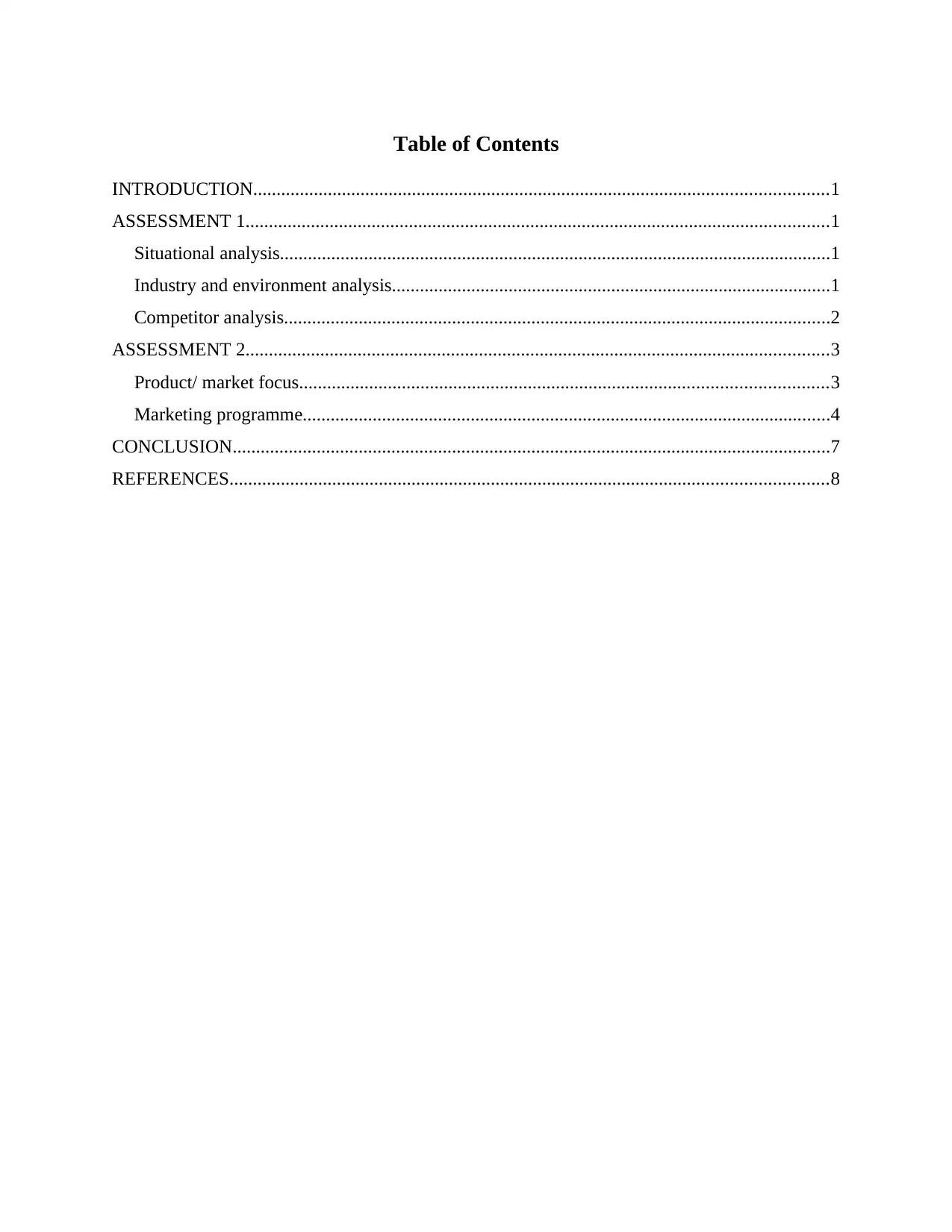
Table of Contents
INTRODUCTION...........................................................................................................................1
ASSESSMENT 1.............................................................................................................................1
Situational analysis......................................................................................................................1
Industry and environment analysis..............................................................................................1
Competitor analysis.....................................................................................................................2
ASSESSMENT 2.............................................................................................................................3
Product/ market focus.................................................................................................................3
Marketing programme.................................................................................................................4
CONCLUSION................................................................................................................................7
REFERENCES................................................................................................................................8
INTRODUCTION...........................................................................................................................1
ASSESSMENT 1.............................................................................................................................1
Situational analysis......................................................................................................................1
Industry and environment analysis..............................................................................................1
Competitor analysis.....................................................................................................................2
ASSESSMENT 2.............................................................................................................................3
Product/ market focus.................................................................................................................3
Marketing programme.................................................................................................................4
CONCLUSION................................................................................................................................7
REFERENCES................................................................................................................................8

⊘ This is a preview!⊘
Do you want full access?
Subscribe today to unlock all pages.

Trusted by 1+ million students worldwide
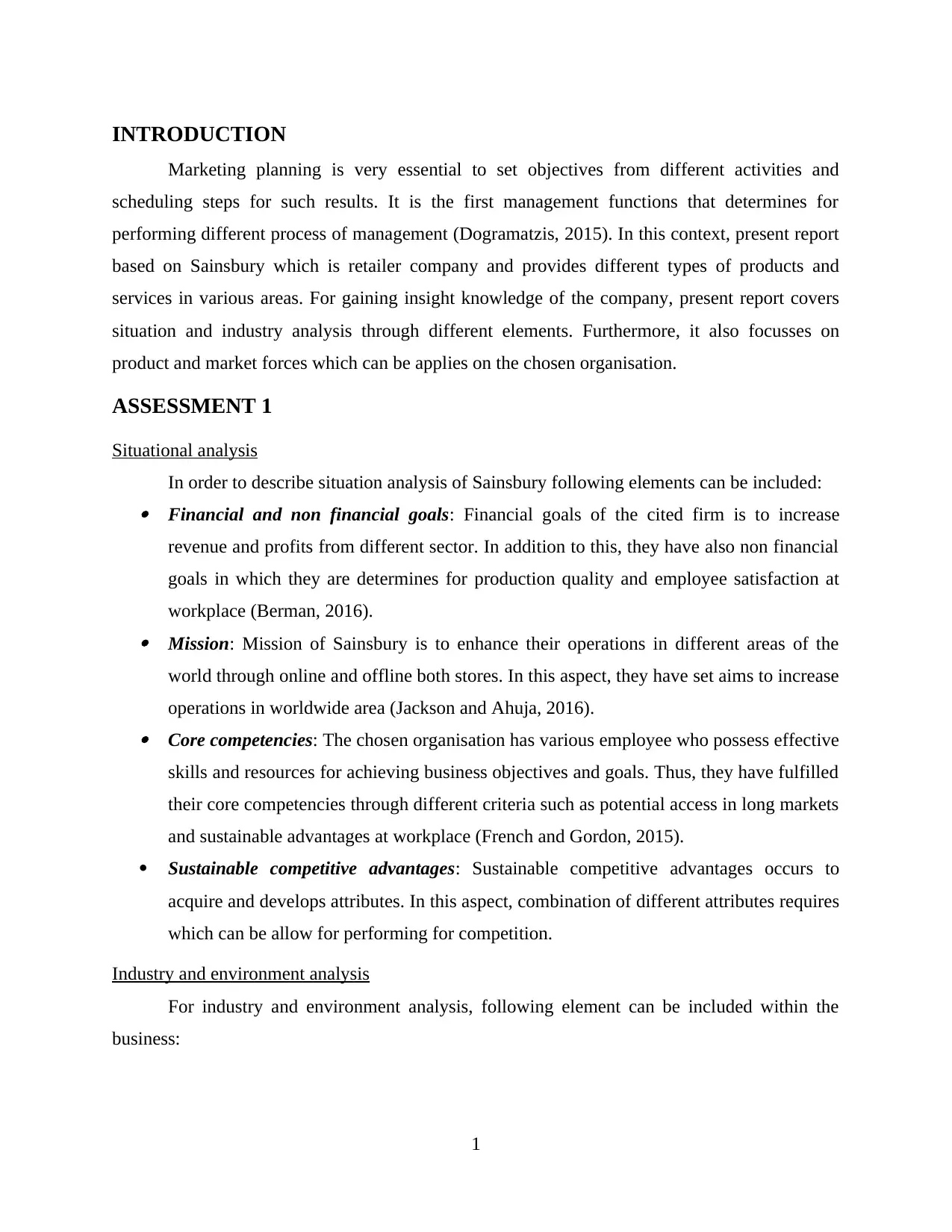
INTRODUCTION
Marketing planning is very essential to set objectives from different activities and
scheduling steps for such results. It is the first management functions that determines for
performing different process of management (Dogramatzis, 2015). In this context, present report
based on Sainsbury which is retailer company and provides different types of products and
services in various areas. For gaining insight knowledge of the company, present report covers
situation and industry analysis through different elements. Furthermore, it also focusses on
product and market forces which can be applies on the chosen organisation.
ASSESSMENT 1
Situational analysis
In order to describe situation analysis of Sainsbury following elements can be included: Financial and non financial goals: Financial goals of the cited firm is to increase
revenue and profits from different sector. In addition to this, they have also non financial
goals in which they are determines for production quality and employee satisfaction at
workplace (Berman, 2016). Mission: Mission of Sainsbury is to enhance their operations in different areas of the
world through online and offline both stores. In this aspect, they have set aims to increase
operations in worldwide area (Jackson and Ahuja, 2016). Core competencies: The chosen organisation has various employee who possess effective
skills and resources for achieving business objectives and goals. Thus, they have fulfilled
their core competencies through different criteria such as potential access in long markets
and sustainable advantages at workplace (French and Gordon, 2015).
Sustainable competitive advantages: Sustainable competitive advantages occurs to
acquire and develops attributes. In this aspect, combination of different attributes requires
which can be allow for performing for competition.
Industry and environment analysis
For industry and environment analysis, following element can be included within the
business:
1
Marketing planning is very essential to set objectives from different activities and
scheduling steps for such results. It is the first management functions that determines for
performing different process of management (Dogramatzis, 2015). In this context, present report
based on Sainsbury which is retailer company and provides different types of products and
services in various areas. For gaining insight knowledge of the company, present report covers
situation and industry analysis through different elements. Furthermore, it also focusses on
product and market forces which can be applies on the chosen organisation.
ASSESSMENT 1
Situational analysis
In order to describe situation analysis of Sainsbury following elements can be included: Financial and non financial goals: Financial goals of the cited firm is to increase
revenue and profits from different sector. In addition to this, they have also non financial
goals in which they are determines for production quality and employee satisfaction at
workplace (Berman, 2016). Mission: Mission of Sainsbury is to enhance their operations in different areas of the
world through online and offline both stores. In this aspect, they have set aims to increase
operations in worldwide area (Jackson and Ahuja, 2016). Core competencies: The chosen organisation has various employee who possess effective
skills and resources for achieving business objectives and goals. Thus, they have fulfilled
their core competencies through different criteria such as potential access in long markets
and sustainable advantages at workplace (French and Gordon, 2015).
Sustainable competitive advantages: Sustainable competitive advantages occurs to
acquire and develops attributes. In this aspect, combination of different attributes requires
which can be allow for performing for competition.
Industry and environment analysis
For industry and environment analysis, following element can be included within the
business:
1
Paraphrase This Document
Need a fresh take? Get an instant paraphrase of this document with our AI Paraphraser
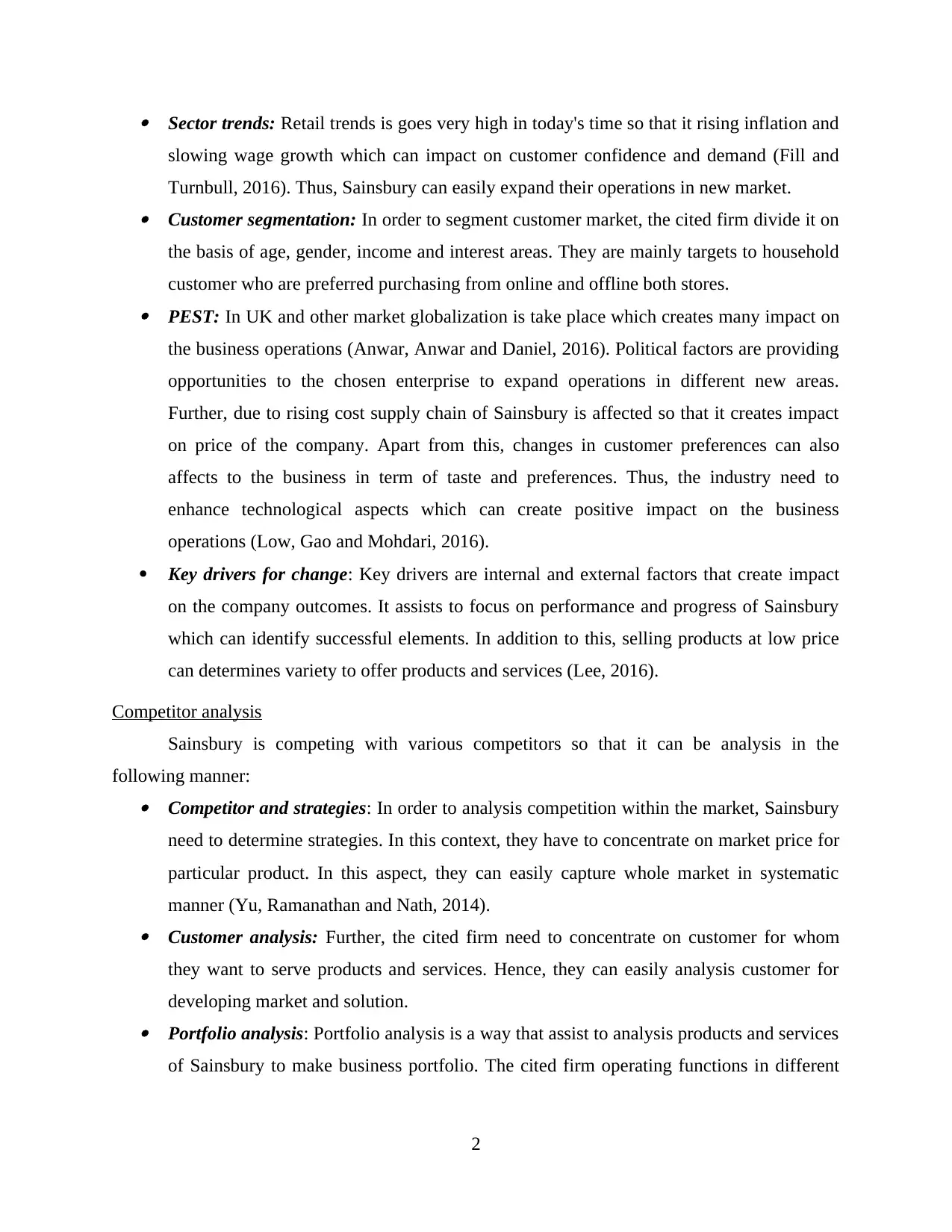
Sector trends: Retail trends is goes very high in today's time so that it rising inflation and
slowing wage growth which can impact on customer confidence and demand (Fill and
Turnbull, 2016). Thus, Sainsbury can easily expand their operations in new market. Customer segmentation: In order to segment customer market, the cited firm divide it on
the basis of age, gender, income and interest areas. They are mainly targets to household
customer who are preferred purchasing from online and offline both stores. PEST: In UK and other market globalization is take place which creates many impact on
the business operations (Anwar, Anwar and Daniel, 2016). Political factors are providing
opportunities to the chosen enterprise to expand operations in different new areas.
Further, due to rising cost supply chain of Sainsbury is affected so that it creates impact
on price of the company. Apart from this, changes in customer preferences can also
affects to the business in term of taste and preferences. Thus, the industry need to
enhance technological aspects which can create positive impact on the business
operations (Low, Gao and Mohdari, 2016).
Key drivers for change: Key drivers are internal and external factors that create impact
on the company outcomes. It assists to focus on performance and progress of Sainsbury
which can identify successful elements. In addition to this, selling products at low price
can determines variety to offer products and services (Lee, 2016).
Competitor analysis
Sainsbury is competing with various competitors so that it can be analysis in the
following manner: Competitor and strategies: In order to analysis competition within the market, Sainsbury
need to determine strategies. In this context, they have to concentrate on market price for
particular product. In this aspect, they can easily capture whole market in systematic
manner (Yu, Ramanathan and Nath, 2014). Customer analysis: Further, the cited firm need to concentrate on customer for whom
they want to serve products and services. Hence, they can easily analysis customer for
developing market and solution. Portfolio analysis: Portfolio analysis is a way that assist to analysis products and services
of Sainsbury to make business portfolio. The cited firm operating functions in different
2
slowing wage growth which can impact on customer confidence and demand (Fill and
Turnbull, 2016). Thus, Sainsbury can easily expand their operations in new market. Customer segmentation: In order to segment customer market, the cited firm divide it on
the basis of age, gender, income and interest areas. They are mainly targets to household
customer who are preferred purchasing from online and offline both stores. PEST: In UK and other market globalization is take place which creates many impact on
the business operations (Anwar, Anwar and Daniel, 2016). Political factors are providing
opportunities to the chosen enterprise to expand operations in different new areas.
Further, due to rising cost supply chain of Sainsbury is affected so that it creates impact
on price of the company. Apart from this, changes in customer preferences can also
affects to the business in term of taste and preferences. Thus, the industry need to
enhance technological aspects which can create positive impact on the business
operations (Low, Gao and Mohdari, 2016).
Key drivers for change: Key drivers are internal and external factors that create impact
on the company outcomes. It assists to focus on performance and progress of Sainsbury
which can identify successful elements. In addition to this, selling products at low price
can determines variety to offer products and services (Lee, 2016).
Competitor analysis
Sainsbury is competing with various competitors so that it can be analysis in the
following manner: Competitor and strategies: In order to analysis competition within the market, Sainsbury
need to determine strategies. In this context, they have to concentrate on market price for
particular product. In this aspect, they can easily capture whole market in systematic
manner (Yu, Ramanathan and Nath, 2014). Customer analysis: Further, the cited firm need to concentrate on customer for whom
they want to serve products and services. Hence, they can easily analysis customer for
developing market and solution. Portfolio analysis: Portfolio analysis is a way that assist to analysis products and services
of Sainsbury to make business portfolio. The cited firm operating functions in different
2
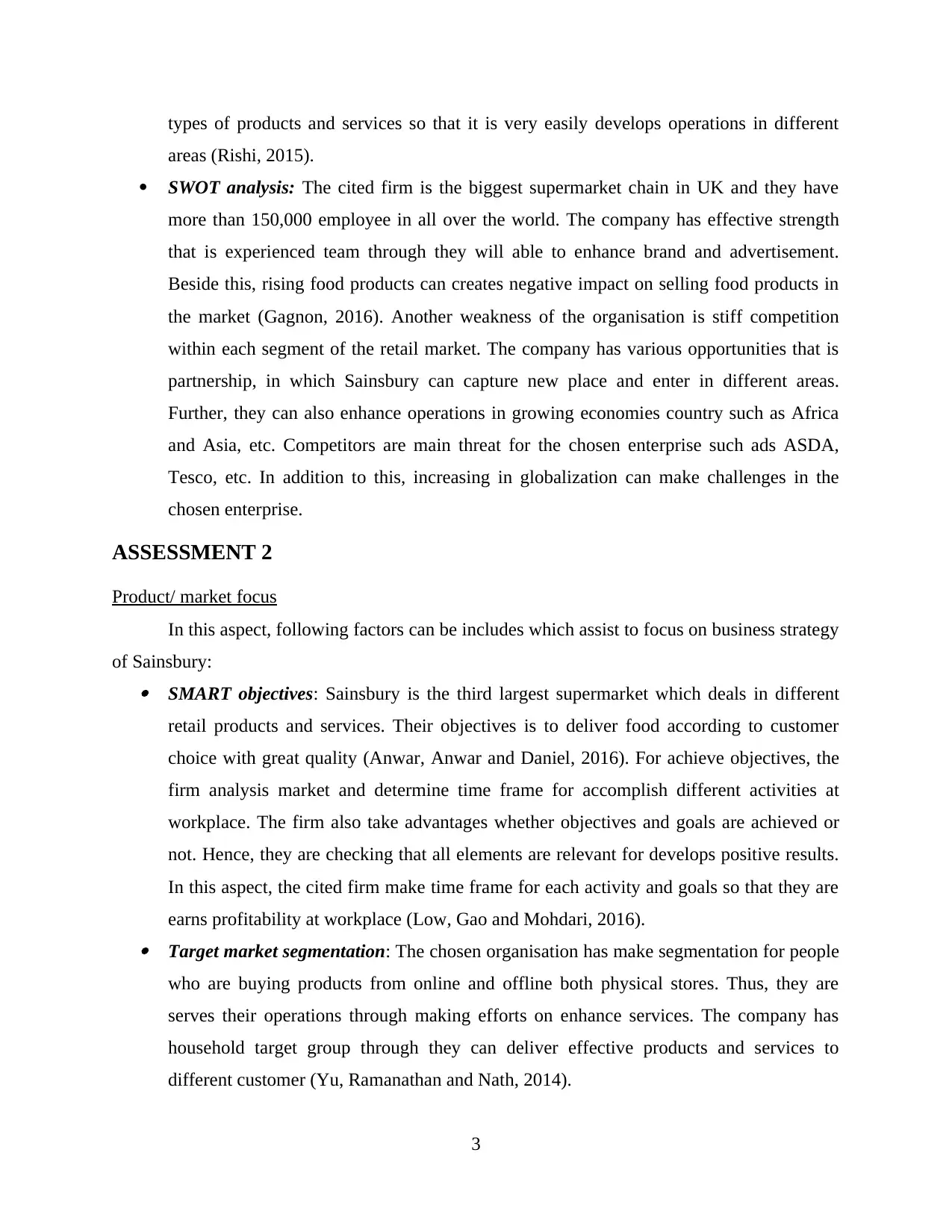
types of products and services so that it is very easily develops operations in different
areas (Rishi, 2015).
SWOT analysis: The cited firm is the biggest supermarket chain in UK and they have
more than 150,000 employee in all over the world. The company has effective strength
that is experienced team through they will able to enhance brand and advertisement.
Beside this, rising food products can creates negative impact on selling food products in
the market (Gagnon, 2016). Another weakness of the organisation is stiff competition
within each segment of the retail market. The company has various opportunities that is
partnership, in which Sainsbury can capture new place and enter in different areas.
Further, they can also enhance operations in growing economies country such as Africa
and Asia, etc. Competitors are main threat for the chosen enterprise such ads ASDA,
Tesco, etc. In addition to this, increasing in globalization can make challenges in the
chosen enterprise.
ASSESSMENT 2
Product/ market focus
In this aspect, following factors can be includes which assist to focus on business strategy
of Sainsbury: SMART objectives: Sainsbury is the third largest supermarket which deals in different
retail products and services. Their objectives is to deliver food according to customer
choice with great quality (Anwar, Anwar and Daniel, 2016). For achieve objectives, the
firm analysis market and determine time frame for accomplish different activities at
workplace. The firm also take advantages whether objectives and goals are achieved or
not. Hence, they are checking that all elements are relevant for develops positive results.
In this aspect, the cited firm make time frame for each activity and goals so that they are
earns profitability at workplace (Low, Gao and Mohdari, 2016). Target market segmentation: The chosen organisation has make segmentation for people
who are buying products from online and offline both physical stores. Thus, they are
serves their operations through making efforts on enhance services. The company has
household target group through they can deliver effective products and services to
different customer (Yu, Ramanathan and Nath, 2014).
3
areas (Rishi, 2015).
SWOT analysis: The cited firm is the biggest supermarket chain in UK and they have
more than 150,000 employee in all over the world. The company has effective strength
that is experienced team through they will able to enhance brand and advertisement.
Beside this, rising food products can creates negative impact on selling food products in
the market (Gagnon, 2016). Another weakness of the organisation is stiff competition
within each segment of the retail market. The company has various opportunities that is
partnership, in which Sainsbury can capture new place and enter in different areas.
Further, they can also enhance operations in growing economies country such as Africa
and Asia, etc. Competitors are main threat for the chosen enterprise such ads ASDA,
Tesco, etc. In addition to this, increasing in globalization can make challenges in the
chosen enterprise.
ASSESSMENT 2
Product/ market focus
In this aspect, following factors can be includes which assist to focus on business strategy
of Sainsbury: SMART objectives: Sainsbury is the third largest supermarket which deals in different
retail products and services. Their objectives is to deliver food according to customer
choice with great quality (Anwar, Anwar and Daniel, 2016). For achieve objectives, the
firm analysis market and determine time frame for accomplish different activities at
workplace. The firm also take advantages whether objectives and goals are achieved or
not. Hence, they are checking that all elements are relevant for develops positive results.
In this aspect, the cited firm make time frame for each activity and goals so that they are
earns profitability at workplace (Low, Gao and Mohdari, 2016). Target market segmentation: The chosen organisation has make segmentation for people
who are buying products from online and offline both physical stores. Thus, they are
serves their operations through making efforts on enhance services. The company has
household target group through they can deliver effective products and services to
different customer (Yu, Ramanathan and Nath, 2014).
3
⊘ This is a preview!⊘
Do you want full access?
Subscribe today to unlock all pages.

Trusted by 1+ million students worldwide
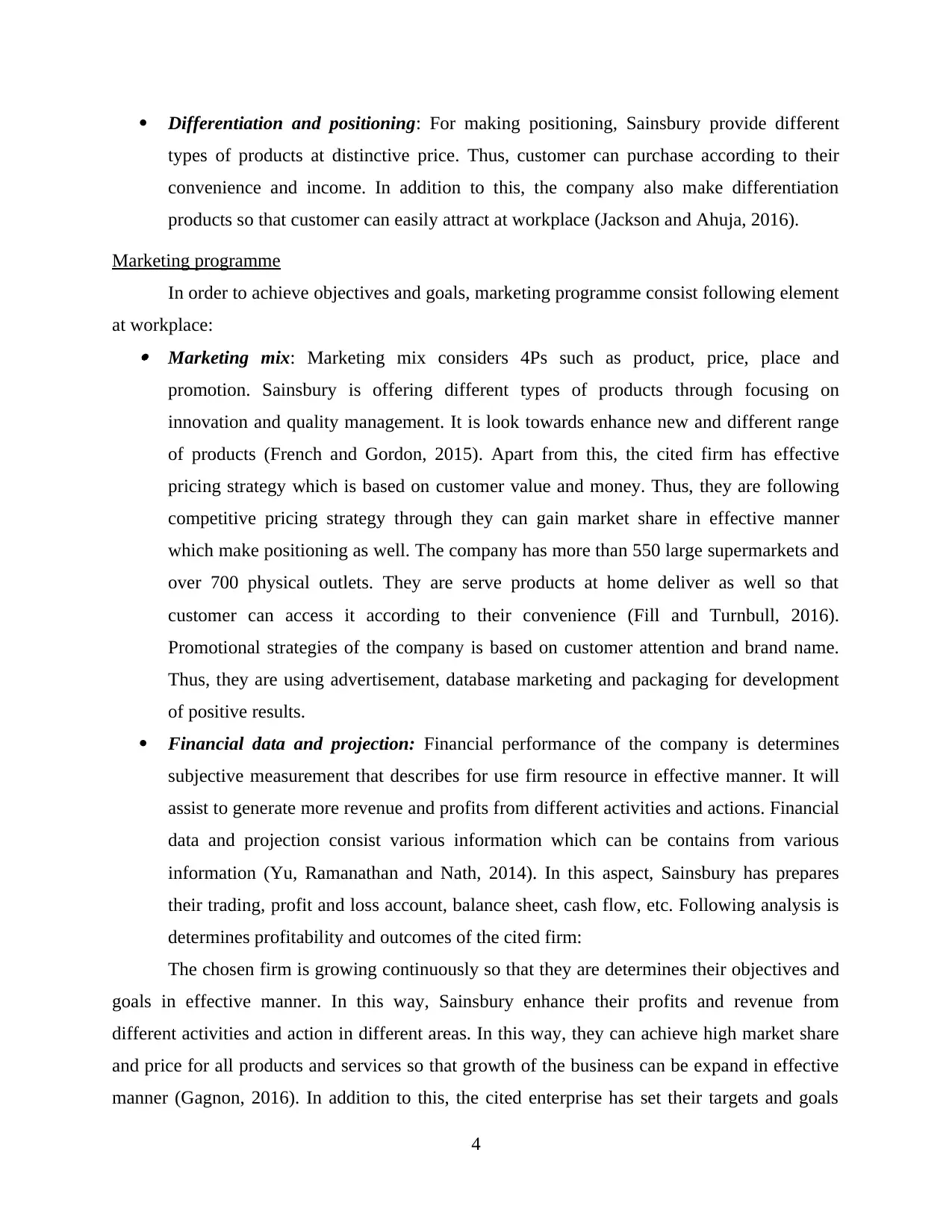
Differentiation and positioning: For making positioning, Sainsbury provide different
types of products at distinctive price. Thus, customer can purchase according to their
convenience and income. In addition to this, the company also make differentiation
products so that customer can easily attract at workplace (Jackson and Ahuja, 2016).
Marketing programme
In order to achieve objectives and goals, marketing programme consist following element
at workplace: Marketing mix: Marketing mix considers 4Ps such as product, price, place and
promotion. Sainsbury is offering different types of products through focusing on
innovation and quality management. It is look towards enhance new and different range
of products (French and Gordon, 2015). Apart from this, the cited firm has effective
pricing strategy which is based on customer value and money. Thus, they are following
competitive pricing strategy through they can gain market share in effective manner
which make positioning as well. The company has more than 550 large supermarkets and
over 700 physical outlets. They are serve products at home deliver as well so that
customer can access it according to their convenience (Fill and Turnbull, 2016).
Promotional strategies of the company is based on customer attention and brand name.
Thus, they are using advertisement, database marketing and packaging for development
of positive results.
Financial data and projection: Financial performance of the company is determines
subjective measurement that describes for use firm resource in effective manner. It will
assist to generate more revenue and profits from different activities and actions. Financial
data and projection consist various information which can be contains from various
information (Yu, Ramanathan and Nath, 2014). In this aspect, Sainsbury has prepares
their trading, profit and loss account, balance sheet, cash flow, etc. Following analysis is
determines profitability and outcomes of the cited firm:
The chosen firm is growing continuously so that they are determines their objectives and
goals in effective manner. In this way, Sainsbury enhance their profits and revenue from
different activities and action in different areas. In this way, they can achieve high market share
and price for all products and services so that growth of the business can be expand in effective
manner (Gagnon, 2016). In addition to this, the cited enterprise has set their targets and goals
4
types of products at distinctive price. Thus, customer can purchase according to their
convenience and income. In addition to this, the company also make differentiation
products so that customer can easily attract at workplace (Jackson and Ahuja, 2016).
Marketing programme
In order to achieve objectives and goals, marketing programme consist following element
at workplace: Marketing mix: Marketing mix considers 4Ps such as product, price, place and
promotion. Sainsbury is offering different types of products through focusing on
innovation and quality management. It is look towards enhance new and different range
of products (French and Gordon, 2015). Apart from this, the cited firm has effective
pricing strategy which is based on customer value and money. Thus, they are following
competitive pricing strategy through they can gain market share in effective manner
which make positioning as well. The company has more than 550 large supermarkets and
over 700 physical outlets. They are serve products at home deliver as well so that
customer can access it according to their convenience (Fill and Turnbull, 2016).
Promotional strategies of the company is based on customer attention and brand name.
Thus, they are using advertisement, database marketing and packaging for development
of positive results.
Financial data and projection: Financial performance of the company is determines
subjective measurement that describes for use firm resource in effective manner. It will
assist to generate more revenue and profits from different activities and actions. Financial
data and projection consist various information which can be contains from various
information (Yu, Ramanathan and Nath, 2014). In this aspect, Sainsbury has prepares
their trading, profit and loss account, balance sheet, cash flow, etc. Following analysis is
determines profitability and outcomes of the cited firm:
The chosen firm is growing continuously so that they are determines their objectives and
goals in effective manner. In this way, Sainsbury enhance their profits and revenue from
different activities and action in different areas. In this way, they can achieve high market share
and price for all products and services so that growth of the business can be expand in effective
manner (Gagnon, 2016). In addition to this, the cited enterprise has set their targets and goals
4
Paraphrase This Document
Need a fresh take? Get an instant paraphrase of this document with our AI Paraphraser
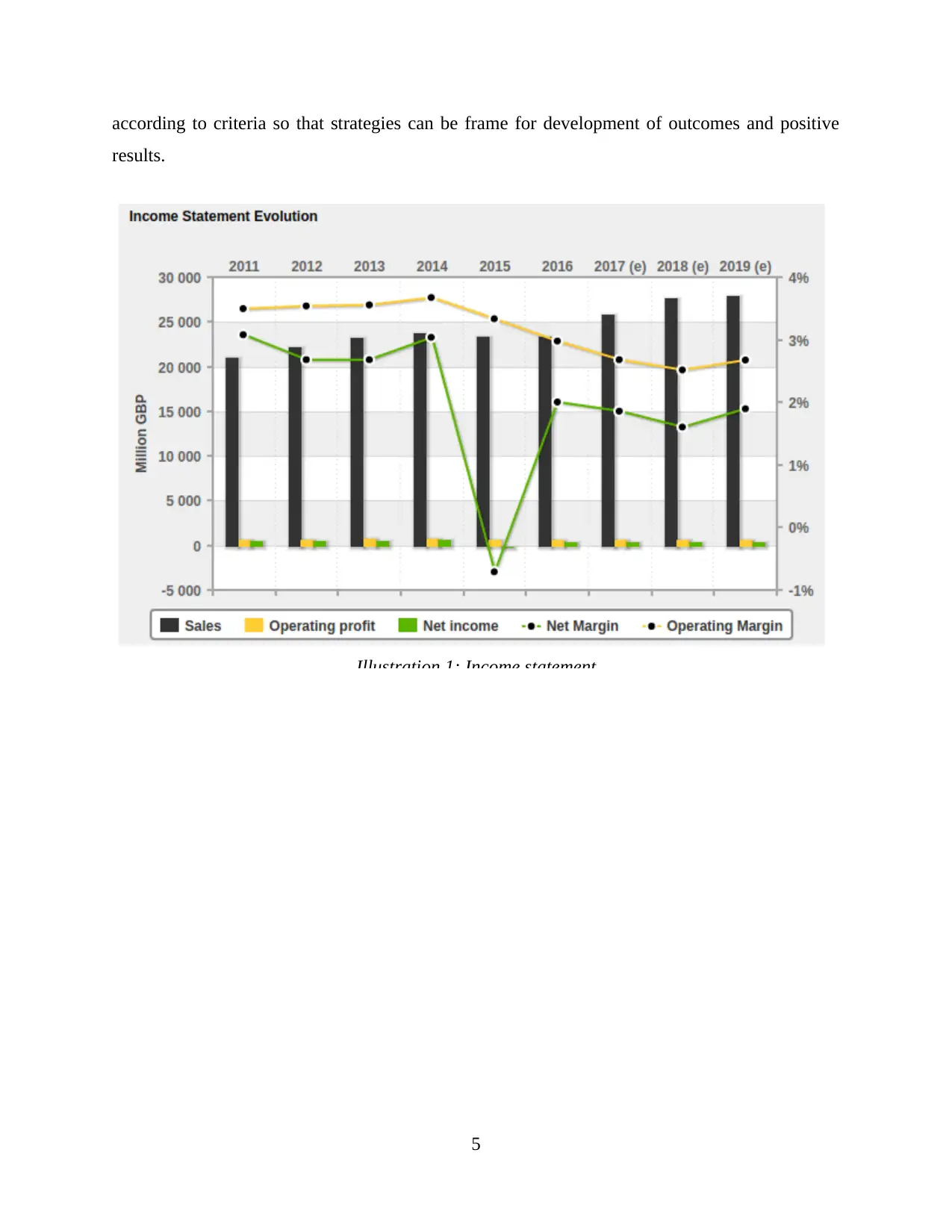
according to criteria so that strategies can be frame for development of outcomes and positive
results.
5
Illustration 1: Income statement
results.
5
Illustration 1: Income statement
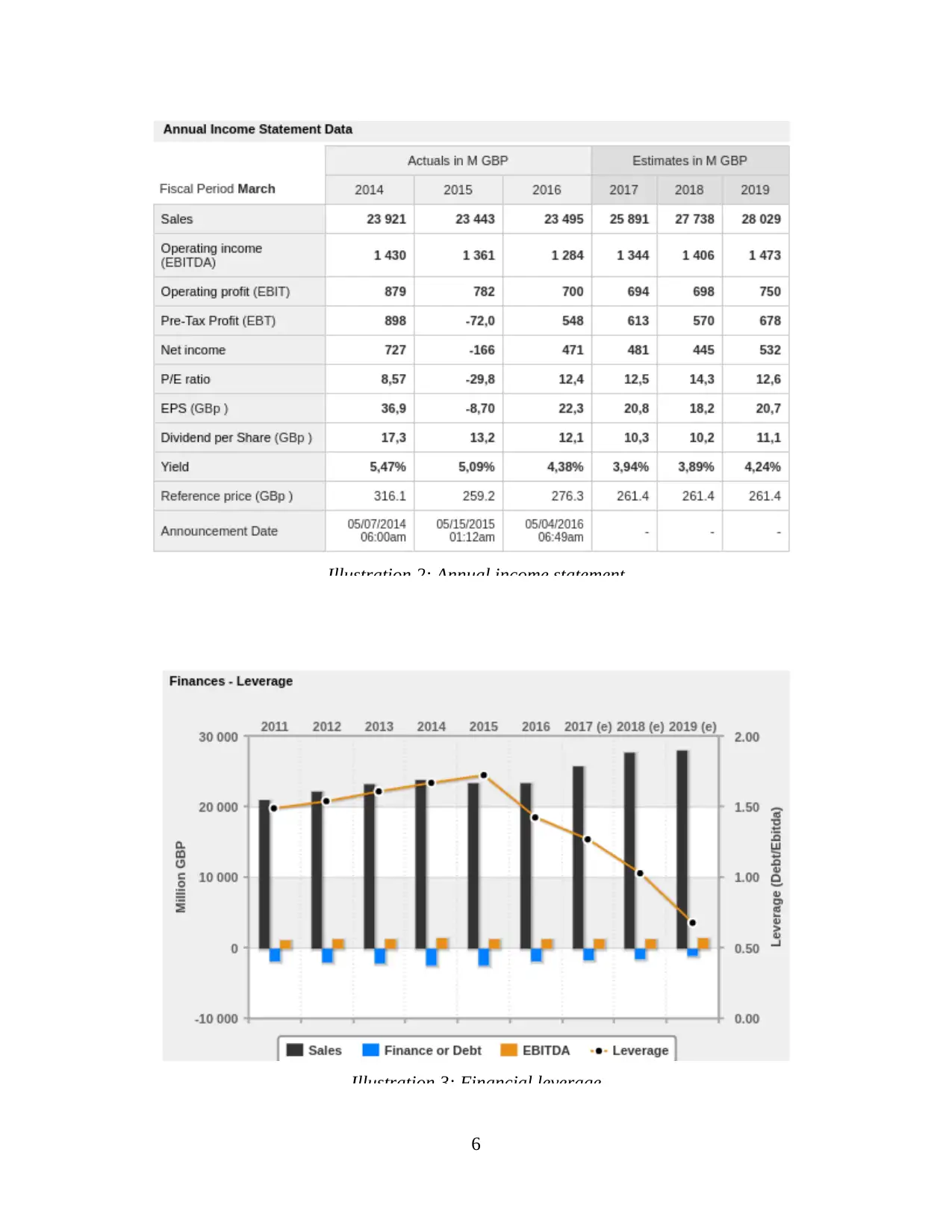
6
Illustration 2: Annual income statement
Illustration 3: Financial leverage
Illustration 2: Annual income statement
Illustration 3: Financial leverage
⊘ This is a preview!⊘
Do you want full access?
Subscribe today to unlock all pages.

Trusted by 1+ million students worldwide
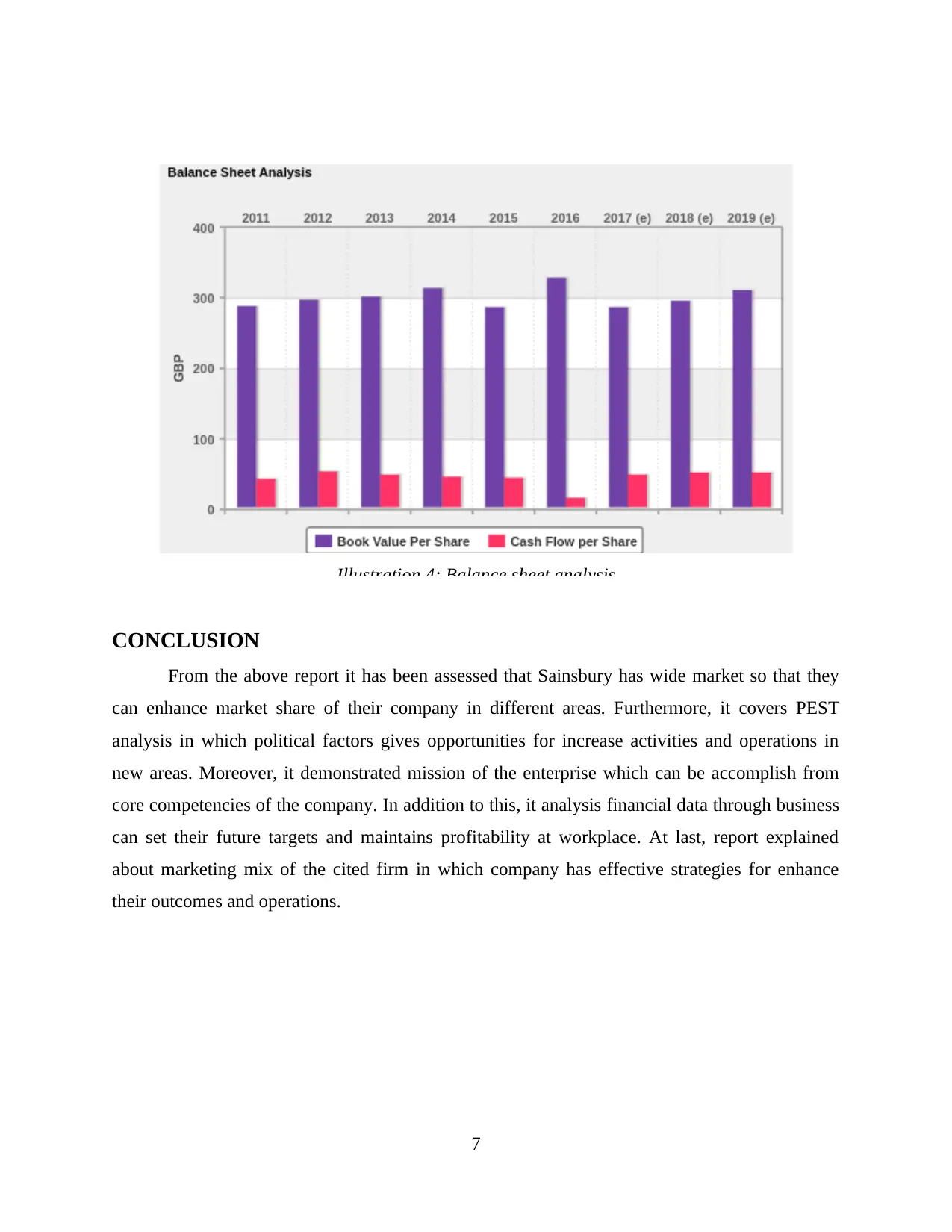
CONCLUSION
From the above report it has been assessed that Sainsbury has wide market so that they
can enhance market share of their company in different areas. Furthermore, it covers PEST
analysis in which political factors gives opportunities for increase activities and operations in
new areas. Moreover, it demonstrated mission of the enterprise which can be accomplish from
core competencies of the company. In addition to this, it analysis financial data through business
can set their future targets and maintains profitability at workplace. At last, report explained
about marketing mix of the cited firm in which company has effective strategies for enhance
their outcomes and operations.
7
Illustration 4: Balance sheet analysis
From the above report it has been assessed that Sainsbury has wide market so that they
can enhance market share of their company in different areas. Furthermore, it covers PEST
analysis in which political factors gives opportunities for increase activities and operations in
new areas. Moreover, it demonstrated mission of the enterprise which can be accomplish from
core competencies of the company. In addition to this, it analysis financial data through business
can set their future targets and maintains profitability at workplace. At last, report explained
about marketing mix of the cited firm in which company has effective strategies for enhance
their outcomes and operations.
7
Illustration 4: Balance sheet analysis
Paraphrase This Document
Need a fresh take? Get an instant paraphrase of this document with our AI Paraphraser
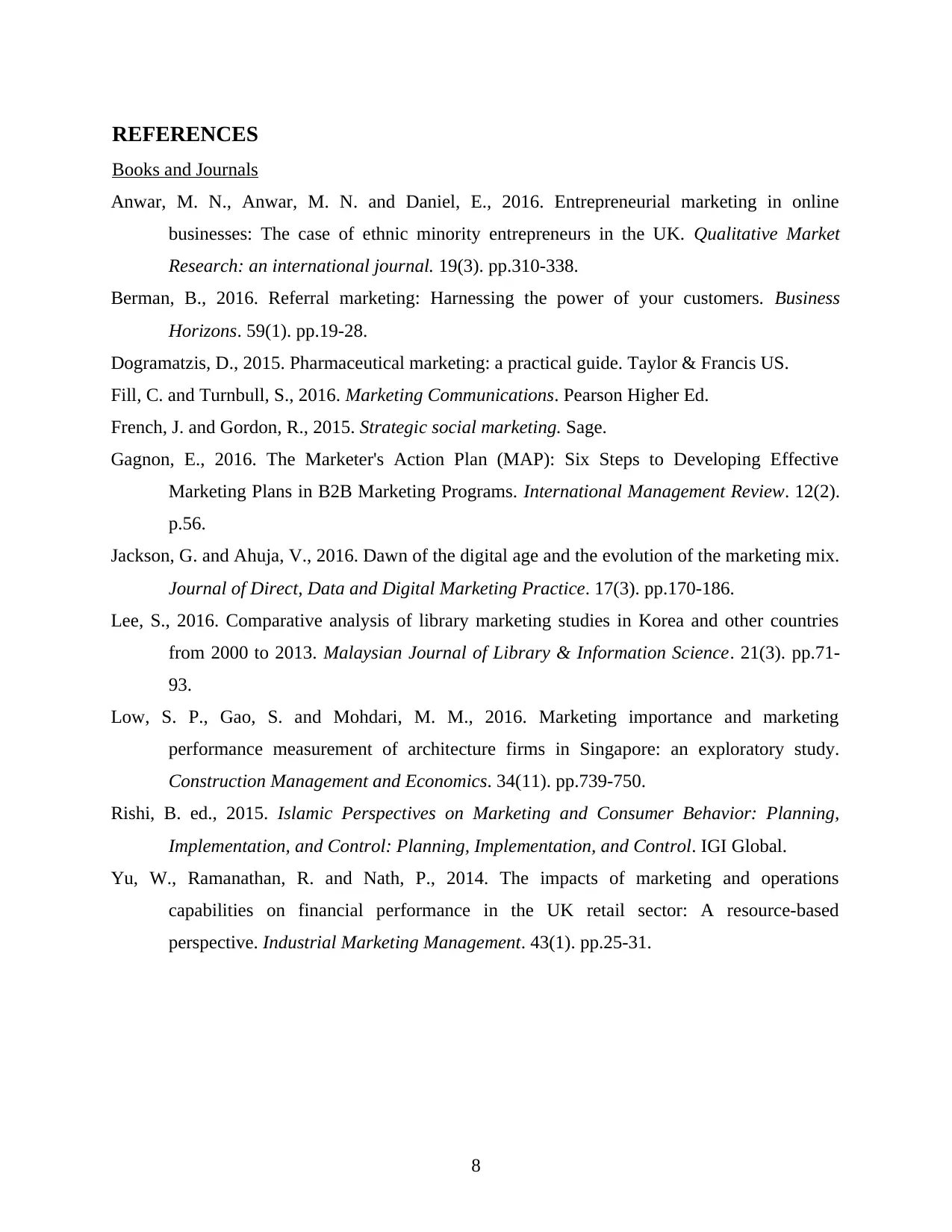
REFERENCES
Books and Journals
Anwar, M. N., Anwar, M. N. and Daniel, E., 2016. Entrepreneurial marketing in online
businesses: The case of ethnic minority entrepreneurs in the UK. Qualitative Market
Research: an international journal. 19(3). pp.310-338.
Berman, B., 2016. Referral marketing: Harnessing the power of your customers. Business
Horizons. 59(1). pp.19-28.
Dogramatzis, D., 2015. Pharmaceutical marketing: a practical guide. Taylor & Francis US.
Fill, C. and Turnbull, S., 2016. Marketing Communications. Pearson Higher Ed.
French, J. and Gordon, R., 2015. Strategic social marketing. Sage.
Gagnon, E., 2016. The Marketer's Action Plan (MAP): Six Steps to Developing Effective
Marketing Plans in B2B Marketing Programs. International Management Review. 12(2).
p.56.
Jackson, G. and Ahuja, V., 2016. Dawn of the digital age and the evolution of the marketing mix.
Journal of Direct, Data and Digital Marketing Practice. 17(3). pp.170-186.
Lee, S., 2016. Comparative analysis of library marketing studies in Korea and other countries
from 2000 to 2013. Malaysian Journal of Library & Information Science. 21(3). pp.71-
93.
Low, S. P., Gao, S. and Mohdari, M. M., 2016. Marketing importance and marketing
performance measurement of architecture firms in Singapore: an exploratory study.
Construction Management and Economics. 34(11). pp.739-750.
Rishi, B. ed., 2015. Islamic Perspectives on Marketing and Consumer Behavior: Planning,
Implementation, and Control: Planning, Implementation, and Control. IGI Global.
Yu, W., Ramanathan, R. and Nath, P., 2014. The impacts of marketing and operations
capabilities on financial performance in the UK retail sector: A resource-based
perspective. Industrial Marketing Management. 43(1). pp.25-31.
8
Books and Journals
Anwar, M. N., Anwar, M. N. and Daniel, E., 2016. Entrepreneurial marketing in online
businesses: The case of ethnic minority entrepreneurs in the UK. Qualitative Market
Research: an international journal. 19(3). pp.310-338.
Berman, B., 2016. Referral marketing: Harnessing the power of your customers. Business
Horizons. 59(1). pp.19-28.
Dogramatzis, D., 2015. Pharmaceutical marketing: a practical guide. Taylor & Francis US.
Fill, C. and Turnbull, S., 2016. Marketing Communications. Pearson Higher Ed.
French, J. and Gordon, R., 2015. Strategic social marketing. Sage.
Gagnon, E., 2016. The Marketer's Action Plan (MAP): Six Steps to Developing Effective
Marketing Plans in B2B Marketing Programs. International Management Review. 12(2).
p.56.
Jackson, G. and Ahuja, V., 2016. Dawn of the digital age and the evolution of the marketing mix.
Journal of Direct, Data and Digital Marketing Practice. 17(3). pp.170-186.
Lee, S., 2016. Comparative analysis of library marketing studies in Korea and other countries
from 2000 to 2013. Malaysian Journal of Library & Information Science. 21(3). pp.71-
93.
Low, S. P., Gao, S. and Mohdari, M. M., 2016. Marketing importance and marketing
performance measurement of architecture firms in Singapore: an exploratory study.
Construction Management and Economics. 34(11). pp.739-750.
Rishi, B. ed., 2015. Islamic Perspectives on Marketing and Consumer Behavior: Planning,
Implementation, and Control: Planning, Implementation, and Control. IGI Global.
Yu, W., Ramanathan, R. and Nath, P., 2014. The impacts of marketing and operations
capabilities on financial performance in the UK retail sector: A resource-based
perspective. Industrial Marketing Management. 43(1). pp.25-31.
8
1 out of 11
Related Documents
Your All-in-One AI-Powered Toolkit for Academic Success.
+13062052269
info@desklib.com
Available 24*7 on WhatsApp / Email
![[object Object]](/_next/static/media/star-bottom.7253800d.svg)
Unlock your academic potential
Copyright © 2020–2025 A2Z Services. All Rights Reserved. Developed and managed by ZUCOL.




